
In order to prove that the House of Rothschild was the hidden hand behind the founding of the Bank of International Settlements [BIS] in Basle, Switzerland – purportedly the central bank for the central banks, pictured above – the following facts need to be sustained with compelling evidence:
- The men who founded BIS were working for or with the House of Rothschild when they founded the bank.
- The governors of the central banks which became members of the BIS board of directors were working for or with the House of Rothschild in their financial policy-making.
- The House of Rothschild has benefited, whether directly or indirectly, from any aspect of the business conducted by BIS.
BIS was founded by four men on 17/05/1930: Hjalmar Schacht [Head of Reichsbank], Charles G Dawes [Chairman of City National Bank], Owen D Young [founder of RCA and chairman of General Electric] and Montague Norman [governor of the Bank of England and partner in JP Morgan].
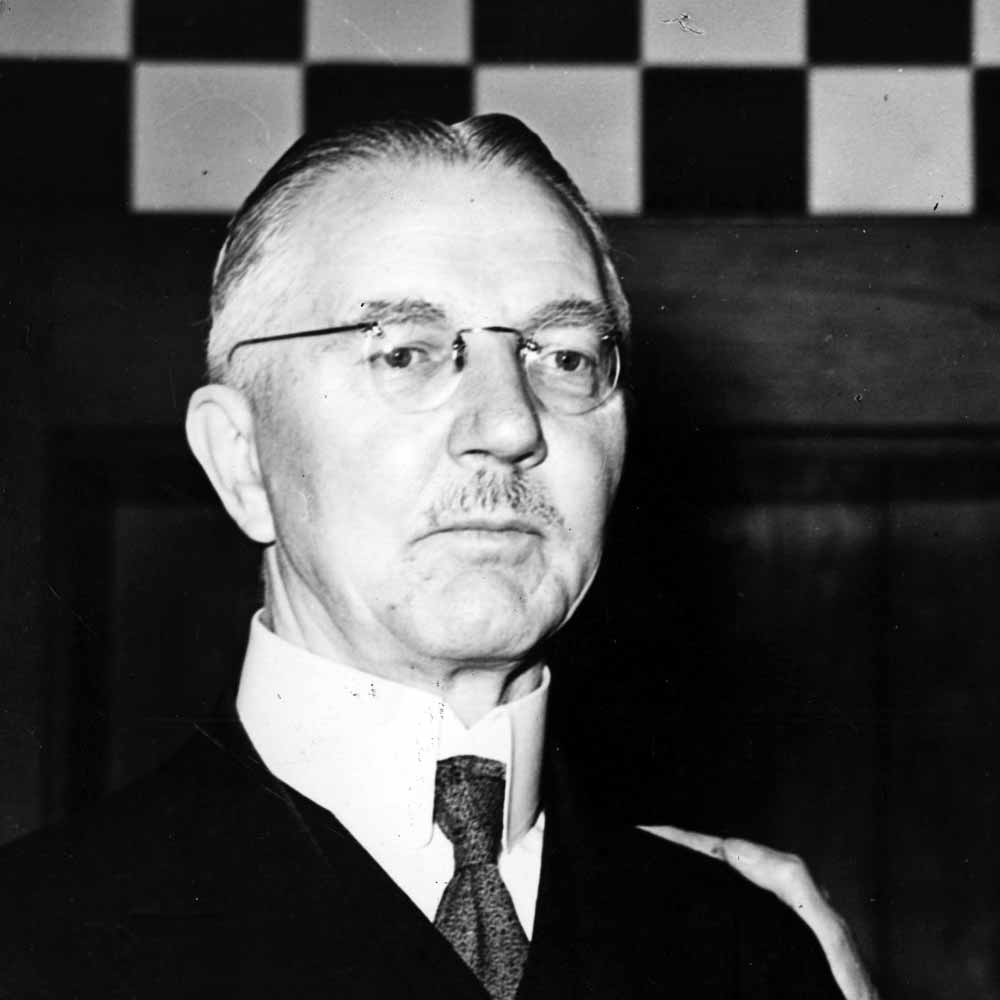
From the founding of the bank until at least 1939, Schacht worked closely with Jacob Schiff, the Warburgs and Montague Norman, in funneling Wall Street and City of London money into Hitler’s rearmament program; as is documented in Professor Antony Sutton’s painstaking work, Wall Street and the Rise of Hitler:
“In October 1931, Warburg received a letter from Hitler which he passed on to Carter at Guaranty Trust Company, and subsequently another bankers’ meeting was called at the Guaranty Trust Company offices. Opinions at this meeting were divided. “Sidney Warburg” reported that Rockefeller, Carter, and McBean were for Hitler, while the other financiers were uncertain.
Montague Norman of the Bank of England and Glean of Royal Dutch Shell argued that the $10 million already spent on Hitler was too much, that Hitler would never act. The meeting finally agreed in principle to assist Hitler further, and Warburg again undertook a courier assignment and went back to Germany.
On this trip Warburg reportedly discussed German affairs with “a Jewish banker” in Hamburg, with an industrial magnate, and other Hitler supporters.
One meeting was with banker von Heydt and a “Luetgebrunn.” The latter stated that the Nazi storm troopers were incompletely equipped and the S.S. badly needed machine guns, revolvers, and carbines.”
This evidence shows that the transfers of those funds into the accounts held in trust by BIS for Hitler’s regime were all facilitated by the Warburgs, a family which long ago assimilated itself into the House of Rothschild by marriage and without whom the Rothschild’s hand in world affairs would not have been capable of remaining hidden for so long.
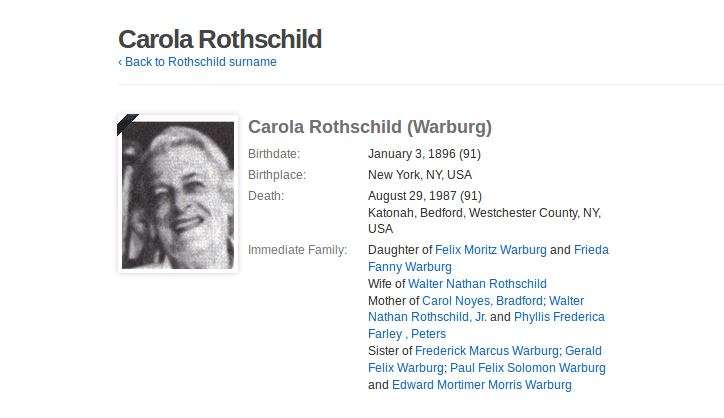
It is therefore fair to deduce from this circumstantial evidence alone that the Warburgs were acting as Rothschild proxies in the financing of Hitler’s rise to power, in which they were aided and abetted by at least two of the four BIS founders, in Schacht and Norman.
Paul Warburg was also the driving force behind the creation of the US Federal Reserve, which congressman Charles Lindbergh described as: “…the most gigantic trust on earth. When the President [Wilson] signs this Bill, the invisible government of the monetary power will be legalised… The greatest crime of the ages is perpetrated by this banking and currency bill.”
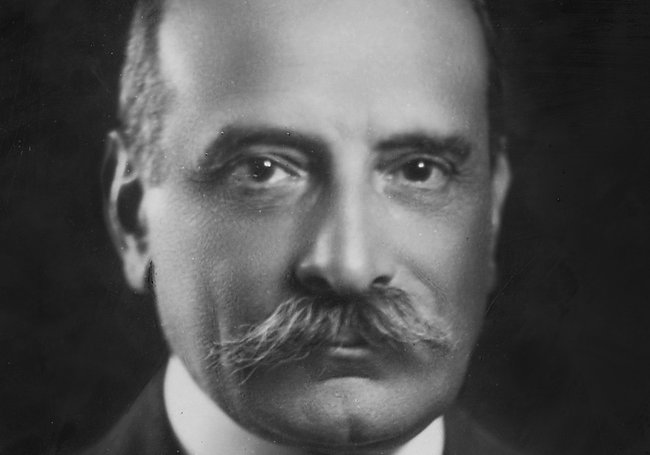
Warburg’s reward for bringing into being the U.S. Federal Reserve was to be its first chairman. While speaking before the House Committee on Banking and Currency in 1913, he confessed that, having emigrated to America in 1902, following an extensive education in international banking in Europe, he became a partner of Kuhn, Loeb & Co, which was to become a Rothschild-controlled shareholder of the American central bank.
It is self-evident that the education Warburg received was given by the Rothschilds, just as it was given to Jacob Schiff whilst he lived at their Frankfurt home before emigrating to America.
Between the American Civil War and the beginning of the First World War, the main U.S. agents of the Rothschild Empire were JP Morgan, Abraham Kuhn and Solomon Loeb. Newsweek magazine published a brief history of Kuhn, Loeb & Co on February 1st 1936, which stated:
“Abraham Kuhn and Solomon Loeb were general merchandise merchants in Lafayette, Indiana, in 1850. As usual in newly settled regions, most transactions were on credit. They soon found out that they were bankers…
In 1867, they established Kuhn, Loeb and Co., bankers, in New York City, and took in a young German immigrant, Jacob Schiff, as partner. Young Schiff had important financial connections in Europe.
After ten years, Jacob Schiff was head of Kuhn, Loeb and Co., Kuhn having retired. Under Schiff’s guidance, the house brought European capital into contact with American industry.”
Those European “financial connections” were the Rothschilds, in whose Frankfurt house Jacob Schiff was purportedly educated; and their German partners, the M.M. Warburg Company of Hamburg and Amsterdam, who were and remain but an extension of the same all-powerful banking house – Rothschild by anther name.
During the latter decades of the previous century, the Rothschilds provided John D. Rockefeller with enough finance to develop and dramatically expand his Standard Oil business. The mechanics of the investment were performed by the Warburgs and Jacob Schiff at Kuhn Loeb, who also financed Edward Harriman’s and Andrew Carnegie’s rail-road and steel empires; whilst JP Morgan’s empire was founded on credit extended by the Rothschild-controlled bank in New York.
It naturally follows that, on the basis that the names of Warburg, Morgan and Schiff are synonymous with that of Rothschild, the banking house is widely considered to have power, control or undue influence over every member of the Federal Reserve board, as well as the selection of its chairman.
In August 1976, the House Banking Committee Staff Report was published, detailing the history of the board members of the Federal Reserve, a portion of which can be seen below:
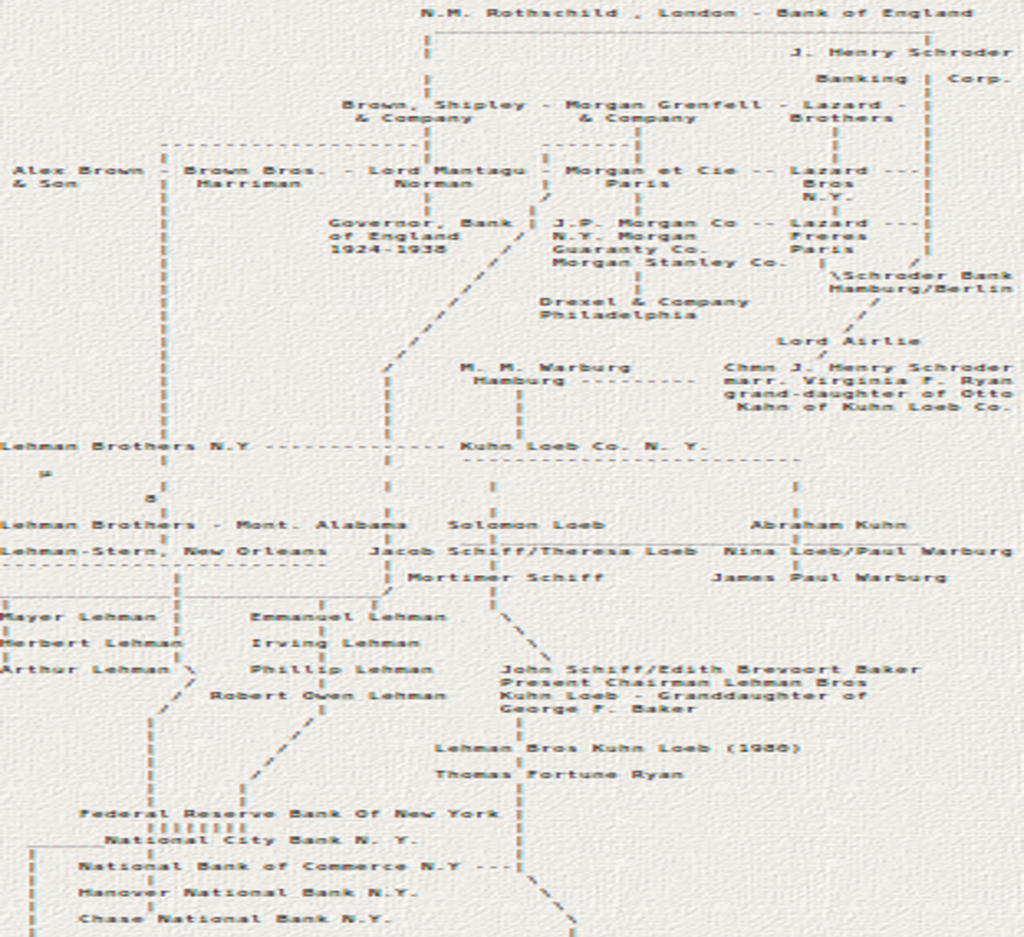
In the event this table is accurate [and there is no reason to believe it is not], there is not one individual or bank or investment company included that could not be considered a Rothschild interest, whether by partnership, investment, lending, commissioning or founding, at the time the Federal Reserve Act was passed into law.
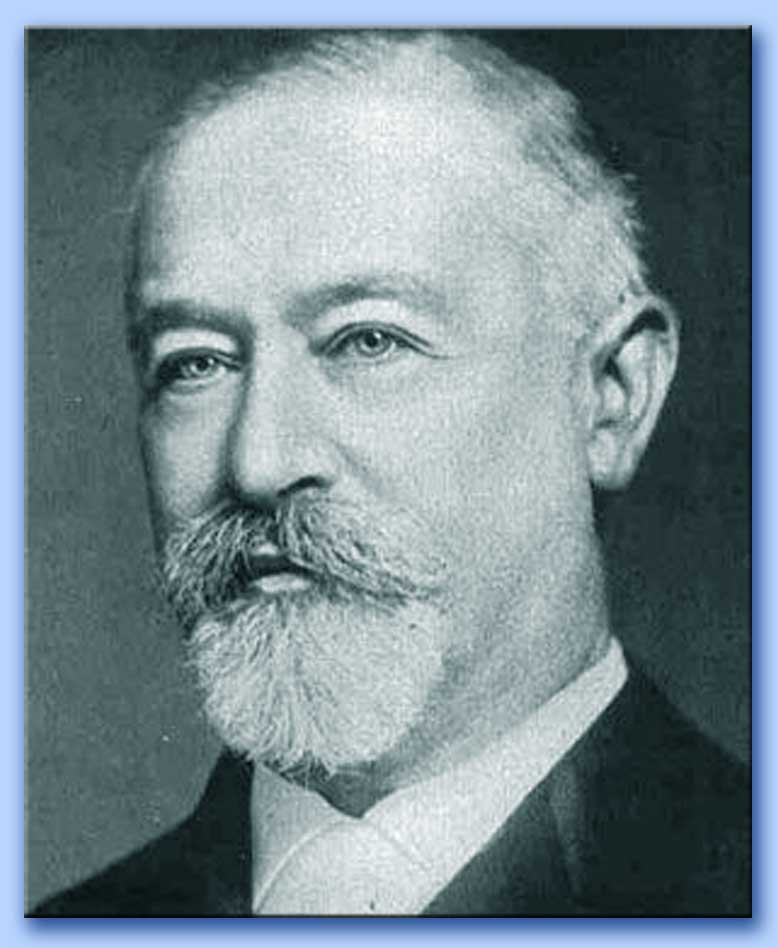
Back in 1907, before the creation of the Federal Reserve, Rothschild-controlled Kuhn Loeb chief, Jacob Schiff, warned the New York Chamber of Commerce that:
“…unless we have a Central Bank with adequate control of credit resources, this country is going to undergo the most severe and far reaching money panic in its history.”
Not long after this speech, the Rothschilds’ agents created a financial panic on Wall Street by making margin calls on the market’s biggest borrowers, just as Nathan Rothschild did by selling government bonds low in the aftermath of the Battle of Waterloo in 1815, both of which resulted in an enormous transfer of wealth to the international bankers during the financial panics that ensued.
Reflecting upon the 1907 panic, Paul Warburg, when speaking to the Banking and Currency Committee, confirmed that he was a driving force behind the Aldrich Plan for the creation of a privately owned US central bank:
“In the Panic of 1907, the first suggestion I made was, “let us have a national clearing house” [Central Bank]. The Aldrich Plan [for a Central Bank] contains many things that are simply fundamental rules of banking. Your aim must be the same.”
In addition to this compelling evidence of the hidden hand of Rothschild influence and control, the Telegraph newspaper published an article on 31/07/2013, detailing the revelations contained in documents released by the Bank of England, concerning the transfer of Czech gold to the Reichsbank BIS account. The article stated:
“The documents reveal a shocking story: just six months before Britain went to war with Nazi Germany, the Bank of England willingly handed over £5.6 million worth of gold to Hitler – and it belonged to another country.
The official history of the bank, written in 1950 but posted online for the first time on Tuesday, reveals how we betrayed Czechoslovakia – not just with the infamous Munich agreement of September 1938, which allowed the Nazis to annex the Sudetenland, but also in London, where Montague Norman, the eccentric but ruthless governor of the Bank of England agreed to surrender gold owned by the National Bank of Czechoslovakia.
The Czechoslovak gold was held in London in a sub-account in the name of the Bank for International Settlements, the Basel-based bank for central banks. When the Nazis marched into Prague in March 1939 they immediately sent armed soldiers to the offices of the National Bank. The Czech directors were ordered, on pain of death, to send two transfer requests.
The first instructed the BIS to transfer 23.1 metric tons of gold from the Czechoslovak BIS account, held at the Bank of England, to the Reichsbank BIS account, also held at Threadneedle Street.
The second order instructed the Bank of England to transfer almost 27 metric tons of gold held in the National Bank of Czechoslovakia’s own name to the BIS’s gold account at the Bank of England.”
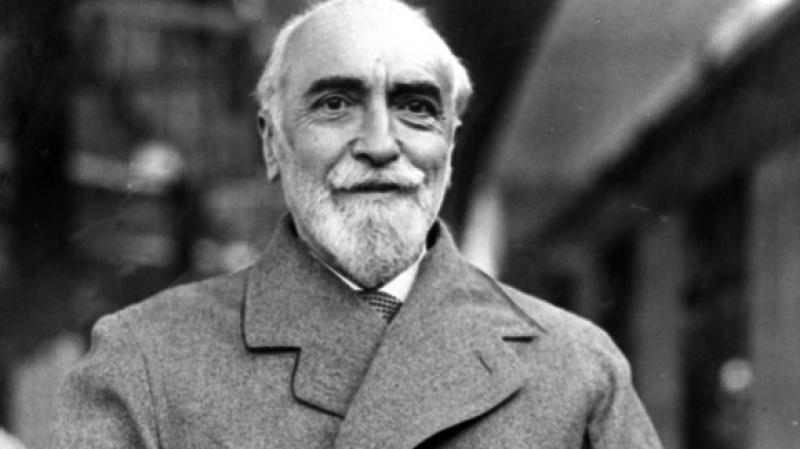
In more simplistic terms, Montague Norman transferred 21 tonnes of Czech gold held by BIS in a Bank of England account, to a Reichsbank account it also held in trust at the English central bank, in order that his friend and fellow central bank head Schacht could finance the final stages of the rearmament of Hitler’s Germany; in addition to transferring 27 tonnes of Czech gold into another BIS account held at the Bank of England, for purposes we can realistically suppose were of a similar criminal nature.
Before any further investigations, it is already clear that Schacht and Norman, the governors of the Reichsbank and the Bank of England respectively, turned a blind eye to a massive theft of wealth from a sovereign nation, to provide arms for the Hitler’s Reich, for whom the drums of war had been beating since 1930. This was done in their unaccountable capacities as trustees of BIS national accounts.
Whilst there is a mountain of additional evidence, for the purposes of this essay, it has already been shown that, on the balance of probabilities, two of the four men who founded BIS were working for or with the House of Rothschild, on the ground that all of the money transferred to Schacht’s Reichbank was sent by Rothschild proxy, Jacob Schiff [or his agents] at Kuhn Loeb; whilst the gold transfer from the Bank of England was authorised by Schacht’s fellow BIS founder, Montague, who both must have known that Hitler’s troops had invaded Prague and that the Czech government would never have consented to gifting such a vast amount of gold to Hitler’s Reich and BIS at the time the transfer was sanctioned.
The only question remaining is whether the House of Rothschild has benefited from the operations of BIS, but the answer arises swiftly from a summary of the answers to the other two questions posed.
We have already established that Schacht and Montague co-founded BIS in 1930 and were carrying out Nazi money laundering operations for Rothschild interests, MM Warburg and Kuhn Loeb; and that Paul Warburg was appointed the first chairman of the Federal Reserve in 1914, after the Act he drafted was passed into law; so it is reasonable to assert that the House of Rothschild benefited from these events in the following ways:
- A Rothschild agent was placed in charge of the issue of American credit, at the helm of a new privately owned US central bank, the board of which was entirely made up of the representatives of Rothschild interests. This meant that when the heads of the central banks were appointed to the BIS board of directors, Rothschild agents were guaranteed influence over the bank’s operations.
The House of Rothschild clearly used their agents, Schacht, Montague, Warburg and Schiff, to fund both sides in WWII in order to provide the circumstances required for the creation of the Zionist state of Israel; which could not have been achieved with such efficiency and secrecy without the participation of BIS, the sovereign bank which grants the protection of immunity from criminal prosecution to any Rothschild agent appointed to the board or to act as its representative, under the terms its Headquarters Agreement with the Swiss Federal Council. This allows Rothschild operations to be carried out above and beyond any legal jurisdiction or national government scrutiny.
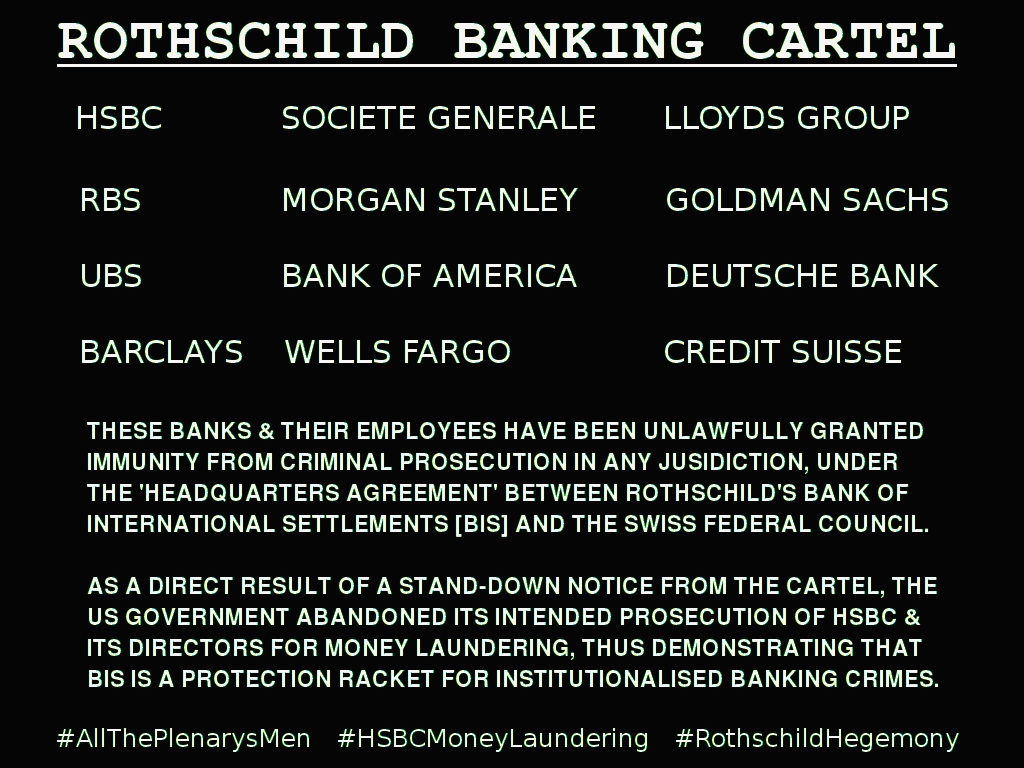
There is a veritable plethora of evidence which would further substantiate the logical assertion that the Rothschilds have benefited, both directly and indirectly, from the operations of the Bank of International Settlements since its creation, but the compelling sources cited in the foregoing passages substantiate that in and of themselves.
The inescapable conclusion is therefore that BIS is and always has been a House of Rothschild interest, despite the fact that the evidence is disguised by the governors of the world’s central banks sitting on the board, every one of which is controlled in much the same way the Rothschilds control the Bank of England and the Federal Reserve. A rigged system in their favour, if ever there was one.




